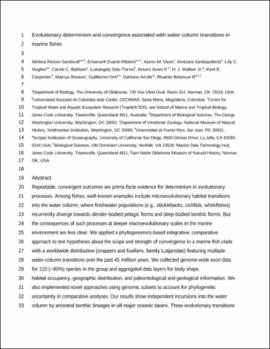| dc.contributor.author | Rincon-Sandoval, Melissa | |
| dc.contributor.author | Duarte-Ribeiro, Emanuell | |
| dc.contributor.author | Davis, Aaron M. | |
| dc.contributor.author | Santaquiteria, Aintzane | |
| dc.contributor.author | Hughes, Lily C. | |
| dc.contributor.author | Baldwin, Carole C. | |
| dc.contributor.author | Soto-Torres, Luisángely | |
| dc.contributor.author | Acero P., Arturo | |
| dc.contributor.author | Walker Jr, H.J. | |
| dc.contributor.author | Carpenter, Kent E. | |
| dc.contributor.author | Sheaves, Marcus | |
| dc.contributor.author | Ortí, Guillermo | |
| dc.contributor.author | Arcila, Dahiana | |
| dc.contributor.author | Betancur-R., Ricardo | |
| dc.date.accessioned | 2021-02-25T20:51:53Z | |
| dc.date.available | 2021-02-25T20:51:53Z | |
| dc.date.issued | 2020-12-16 | |
| dc.identifier.citation | Evolutionary determinism and convergence associated with water-column transitions in marine fishes Melissa Rincon-Sandoval, Emanuell Duarte-Ribeiro, Aaron M. Davis, Aintzane Santaquiteria, Lily C. Hughes, Carole C. Baldwin, Luisángely Soto-Torres, Arturo Acero P., H. J. Walker, Kent E. Carpenter, Marcus Sheaves, Guillermo Ortí, Dahiana Arcila, Ricardo Betancur-R. Proceedings of the National Academy of Sciences Dec 2020, 117 (52) 33396-33403; DOI: 10.1073/pnas.2006511117 | en_US |
| dc.identifier.uri | https://hdl.handle.net/11244/328686 | |
| dc.description.abstract | Repeatable, convergent outcomes are prima facie evidence for determinism in evolutionary processes. Among fishes, well-known examples include microevolutionary habitat transitions into the water column, where freshwater populations (e.g., sticklebacks, cichlids, and whitefishes) recurrently diverge toward slender-bodied pelagic forms and deep-bodied benthic forms. However, the consequences of such processes at deeper macroevolutionary scales in the marine environment are less clear. We applied a phylogenomics-based integrative, comparative approach to test hypotheses about the scope and strength of convergence in a marine fish clade with a worldwide distribution (snappers and fusiliers, family Lutjanidae) featuring multiple water-column transitions over the past 45 million years. We collected genome-wide exon data for 110 (∼80%) species in the group and aggregated data layers for body shape, habitat occupancy, geographic distribution, and paleontological and geological information. We also implemented approaches using genomic subsets to account for phylogenetic uncertainty in comparative analyses. Our results show independent incursions into the water column by ancestral benthic lineages in all major oceanic basins. These evolutionary transitions are persistently associated with convergent phenotypes, where deep-bodied benthic forms with truncate caudal fins repeatedly evolve into slender midwater species with furcate caudal fins. Lineage diversification and transition dynamics vary asymmetrically between habitats, with benthic lineages diversifying faster and colonizing midwater habitats more often than the reverse. Convergent ecological and functional phenotypes along the benthic–pelagic axis are pervasive among different lineages and across vastly different evolutionary scales, achieving predictable high-fitness solutions for similar environmental challenges, ultimately demonstrating strong determinism in fish body-shape evolution. This is a postprint of the published article. | en_US |
| dc.description.sponsorship | This research was supported by NSF grants DEB-1932759 and DEB-1929248 to R.B.-R., DEB-1457426 and DEB-1541554 to G.O., DEB-1541552 to C.C.B., and DEB-2015404 to D.A. M.R.-S. was supported by a postdoctoral fellowship from Colciencias (Grant 848-2019). Financial support was provided from the Office of the Vice President for Research and Partnerships and the Office of the Provost, University of Oklahoma. | en_US |
| dc.language | en_US | en_US |
| dc.subject | Phylogenomics | en_US |
| dc.subject | Macroevolution | en_US |
| dc.subject | Habitat transitions | en_US |
| dc.subject | Benthic–pelagic axis | en_US |
| dc.subject | Lutjanidae | en_US |
| dc.title | Evolutionary determinism and convergence associated with water-column transitions in marine fishes | en_US |
| dc.type | Article | en_US |
| dc.description.peerreview | Yes | en_US |
| dc.identifier.doi | 10.1073/pnas.2006511117 | en_US |
| ou.group | College of Arts and Sciences::Department of Biology | en_US |
